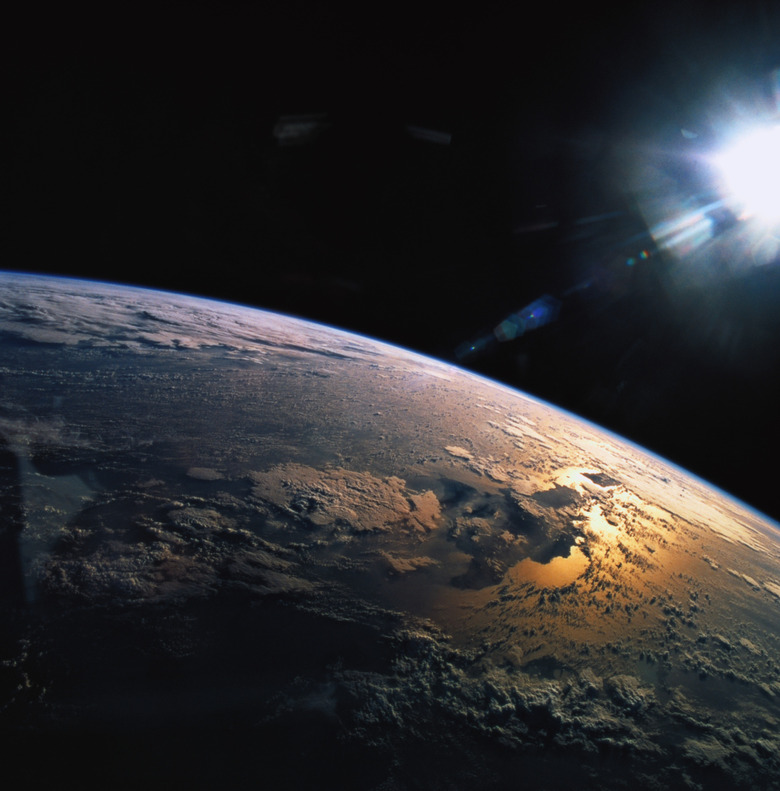Facts About The Sun For Kids
It may resemble a tiny ball of yellow flame lighting up the sky, but the sun is so large it could hold 1 million Earths. The star R136a1, on the other hand, is 256 times bigger and about 9 million times brighter than the sun. Many people may not understand what their stellar neighbor is, where it came from, how it works or details about this star's destiny. Give your kids a simple astronomy lesson, and they'll learn incredible solar facts, such as the time it takes light to travel from the sun's heart to its surface — an astounding 1 million years.
Humble, Gaseous Beginnings
Humble, Gaseous Beginnings
All stars go through stages, beginning with birth and ending in death. The sun formed billions of years ago when hydrogen gas contracted, heated and started a self-sustaining nuclear fusion reaction that converts hydrogen into helium. This stage is the sun's most stable and the one in which you live. That stage also ends in approximately 4.6 billion years when the sun expands, engulfs the Earth and eventually dies as a small white dwarf star.
Earth's Solar Companion Exposed
Earth's Solar Companion Exposed
The sun doesn't resemble a tiny twinkling star in the heavens because you're so close to it. About 149.6 million kilometers (92.96 million miles) away, the sun consists of several distinct layers. Beginning about 2,100 kilometers (1,300 miles) above the surface lies the corona, where temperatures can exceed 500,000 degrees Celsius (900,000 degrees Fahrenheit). Beneath that, the cooler chromosphere rises up to 2,100 kilometers (1,300 miles) above the surface, and below that, the photosphere reaches an altitude of around 400 kilometers (250 miles). The temperature at the surface is only 5,700 degrees Celsius (10,292 degrees Fahrenheit).
Deep in the Heart of the Sun
Deep in the Heart of the Sun
If you could fly a spacecraft into the sun's center, it would take a while to get there, and you'd need incredible AC to stay cool — the mean distance from the surface to the core is 695,508 kilometers (432,168.6 miles). Nuclear fusion, the same process hydrogen bombs use, happens in the sun's core, where temperatures approach a staggering 15 million degrees Celsius (27 million degrees Fahrenheit). Photons generated in the sun's core pass through the radiative zone that surrounds the core. Because these photons bounce frequently during their journey to the surface, it takes about 1 million years for them to get there and head toward Earth and other destinations.
Solar Activity: Turmoil in the Heavens
Solar Activity: Turmoil in the Heavens
Earth's fiery neighbor may look peaceful and serene, but it's quite the opposite. Solar flares, the largest explosive events in the solar system, occur on the surface. These radiation bursts are so powerful that they appear as bright areas on the sun. Coronal mass ejections occur when the sun flings up to a billion tons of matter into space at speeds of up to several million miles per hour. Solar prominences, anchored to the surface, extend outward from the surface for hundreds of thousands of miles. High-energy particles also travel from the sun in all directions inside the "solar wind." These disturbances can cause everything from communication problems to colorful northern light displays.
The Bottom Line: Why You Need the Sun
The Bottom Line: Why You Need the Sun
Earth is at just the right distance from the sun so that liquid water can exist and temperatures fall in the range that supports all life forms.
The sun's gravitational field is so strong that it causes planets, asteroids and comets to revolve around it. In other words, this ordinary star — one among billions — holds your reality together and will do so for the next few billion years.
References
- NASA: Sun – Read More
- Stanford Solar Center: Tell Me About the Lifetime of the Sun
- NASA: Layers of the Sun
- NASA: Sun Facts and Figures
- NASA: The Solar Interior
- NASA: Solar Storm and Space Weather – Frequently Asked Questions
- NASA: Solar Storm and Space Weather – Frequently Asked Questions
- Deep Space: Beyond the Solar System to the End of the Universe and the Beginning of Time; Govert Schilling
- Physics; Graham Dolan et al.
Cite This Article
MLA
Lee, Kevin. "Facts About The Sun For Kids" sciencing.com, https://www.sciencing.com/sun-kids-5377228/. 24 April 2017.
APA
Lee, Kevin. (2017, April 24). Facts About The Sun For Kids. sciencing.com. Retrieved from https://www.sciencing.com/sun-kids-5377228/
Chicago
Lee, Kevin. Facts About The Sun For Kids last modified March 24, 2022. https://www.sciencing.com/sun-kids-5377228/
